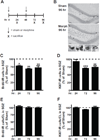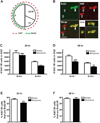Time course of morphine's effects on adult hippocampal subgranular zone reveals preferential inhibition of cells in S phase of the cell cycle and a subpopulation of immature neurons
- PMID: 18832014
- PMCID: PMC3646516
- DOI: 10.1016/j.neuroscience.2008.08.064
Time course of morphine's effects on adult hippocampal subgranular zone reveals preferential inhibition of cells in S phase of the cell cycle and a subpopulation of immature neurons
Abstract
Opiates, such as morphine, decrease neurogenesis in the adult hippocampal subgranular zone (SGZ), raising the possibility that decreased neurogenesis contributes to opiate-induced cognitive deficits. However, there is an incomplete understanding of how alterations in cell cycle progression and progenitor maturation contribute to this decrease. The present study examined how morphine regulates progenitor cell cycle, cell death and immature SGZ neurons (experiment 1) as well as the progression of SGZ progenitors through key stages of maturation (experiment 2). In experiment 1, mice received sham or morphine pellets (s.c., 0 and 48 h) and bromodeoxyuridine (BrdU) 2 h prior to sacrifice (24, 72 or 96 h). Morphine decreased both the number of S phase and total cycling cells, as there were fewer cells immunoreactive (IR) for the S phase marker BrdU and the cell cycle marker Ki67. The percentage of Ki67-IR cells that were BrdU-IR was decreased after 24 but not 96 h of morphine, suggesting a disproportionate effect on S phase cells relative to all cycling cells at this time point. Cell death (activated caspase-3 counts) was increased after 24 but not 96 h. In experiment 2, nestin-green fluorescent protein (GFP) mice given BrdU 1 day prior to morphine or sham surgery (0 and 48 h, sacrifice 96 h) had fewer Ki67-IR cells, but no change in BrdU-IR cell number, suggesting that this population of BrdU-IR cells was less sensitive to morphine. Interestingly, examination of key stages of progenitor cell maturation revealed that morphine increased the percent of BrdU-IR cells that were type 2b and decreased the percent that were immature neurons. These data suggest that chronic morphine decreases SGZ neurogenesis by inhibiting dividing cells, particularly those in S phase, and progenitor cell progression to a more mature neuronal stage.
Figures




References
-
- Altman J, Das GD. Autoradiographic and histological evidence of postnatal hippocampal neurogenesis in rats. J Comp Neurol. 1965;124(3):319–335. - PubMed
-
- Cameron HA, McKay RD. Adult neurogenesis produces a large pool of new granule cells in the dentate gyrus. J Comp Neurol. 2001;435(4):406–417. - PubMed
-
- Canales JJ. Adult neurogenesis and the memories of drug addiction. Eur Arch Psychiatry Clin Neurosci. 2007;257(5):261–270. - PubMed
Publication types
MeSH terms
Substances
Grants and funding
LinkOut - more resources
Full Text Sources
Molecular Biology Databases
Research Materials

